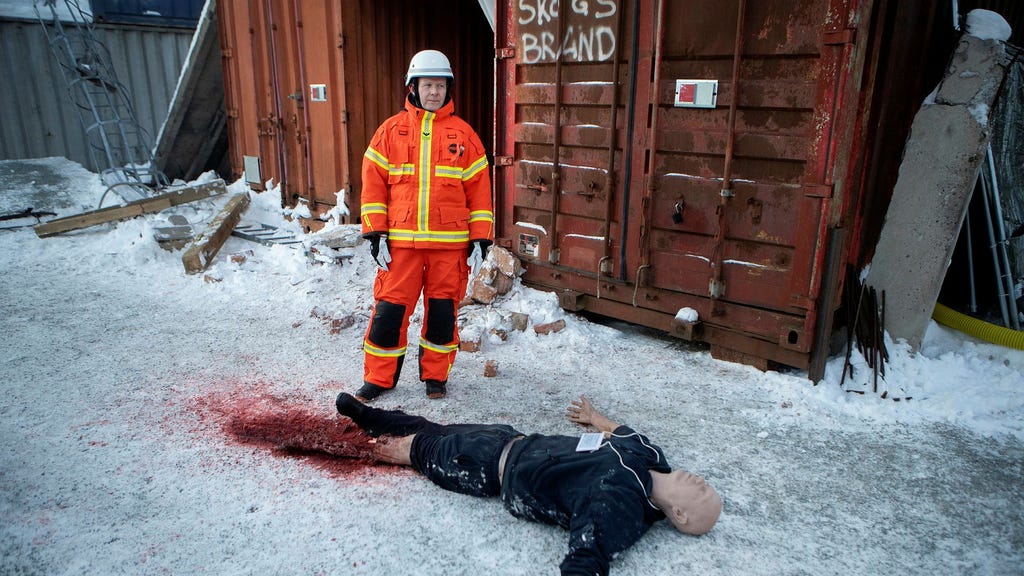Paragraph 1: A Simulated Disaster, A Real Enthusiasm
The scene at MSB’s training facility near Kramfors is one of devastation. A simulated robot attack has ripped through a factory, leaving a chaotic landscape of concrete, steel, and simulated casualties. Amidst this mock disaster, MSB’s new Director General, Mikael Frisell, expresses not horror, but enthusiasm. He sees the realistic exercise as a valuable opportunity to assess and improve Sweden’s civil defense capabilities. This simulated carnage, with its fake blood and mannequins, serves a critical purpose: it’s a crucial training exercise for a group of 16 reservists, formerly trained in emergency response, now being recalled to practice wartime rescue operations. Their task list is grimly contemporary: detecting mines, evading drones, and extracting survivors from rubble – stark reminders of the modern battlefield as seen in Ukraine.
Paragraph 2: The Urgency of Wartime Preparedness
Frisell’s focus is sharp: achieving “effect” from investment. The civil defense is receiving billions in additional funding, and he is determined to avoid bureaucratic delays and ensure value for every krona spent. He underscores the stark realities of modern warfare, citing Russia’s disregard for civilian lives in Ukraine as a chilling example. This necessitates a fundamental shift in preparedness, focusing not just on traditional disaster response, but on the grim realities of war. He stresses the importance of equipping the public with basic medical skills like CPR and hemorrhage control, highlighting them as crucial, life-saving lessons from the Ukrainian conflict. This emphasis on basic medical training is not just for professional rescuers but aimed at the general populace. This stark realization informs MSB’s updated “If Crisis or War Comes” brochure, urging citizens to acquire basic life-saving skills, reminding them that even simple actions like applying pressure to a wound can mean the difference between life and death.
Paragraph 3: A Controversial Brochure and International Headlines
The brochure, encouraging citizens to learn basic first aid and become blood donors, has sparked international concern, with headlines suggesting Sweden is preparing for World War III or nuclear armageddon. Frisell acknowledges the unexpected attention but attributes it to the timing of the brochure’s release, coinciding with heightened geopolitical tensions surrounding Ukraine. While not dismissing the possibility of war, he emphasizes that there is no immediate threat and that a diverse range of outcomes are possible. His background is uniquely suited to this particular moment. Frisell, a former Major General and Chief of Staff at the Swedish Defence Materiel Administration (FMV), brings decades of military experience to his new civilian role. This extensive service, culminating in his involvement in high-level military discussions with Russia just months before their annexation of Crimea, provides a unique perspective on the current security landscape.
Paragraph 4: From Crisis Response to Civil Defense
The shift in focus from crisis management to war preparedness is further reflected in the impending name change of MSB to the Swedish Civil Defence Agency by 2026. Minister for Civil Defence, Carl-Oskar Bohlin, emphasizes Frisell’s role in driving this transformation, highlighting his “energy” and “drive” and envisioning him bridging the gap between military and civilian defense. Recognizing the significant rebuilding required after decades of neglect, following the Cold War-era dismantling of civil defense structures, Bohlin acknowledges the challenge of accelerating the pace of development. A significant increase in funding, from 8.5 billion kronor this year to 15 billion annually from 2028, signifies a commitment to bolstering the civil defense, though even this represents a compromise considering MSB’s initial proposal of 20 billion per year.
Paragraph 5: The Weight of Responsibility
Frisell’s commitment extends beyond office hours. Even during his Christmas leave in Boden, he carries encrypted communication devices, ensuring constant accessibility in case of emergencies. This constant vigilance is particularly relevant given the anniversary of the 2004 tsunami disaster, a stark reminder of the importance of effective crisis management. He intends to translate his military experience of "administrative battlefield clearance," streamlining bureaucracy, into tangible results at the local level. The transformation of MSB entails substantial change for its 1,200 employees, requiring alignment across all levels to implement the new defense decisions and embody the agency’s new identity. This includes practicalities like a new logo and uniforms, symbolizing the agency’s evolving purpose.
Paragraph 6: Lessons Learned and a Call to Action
The war in Ukraine has provided invaluable, albeit tragic, lessons for the evolution of Sweden’s civil defense. MSB’s recommendations focus on crucial areas including protecting civilians, securing essential services, and supporting the military. As the designated lead agency, the soon-to-be Swedish Civil Defence Agency will play a pivotal role in coordinating these efforts across various governmental levels. Frisell stresses the importance of genuine collaboration, moving beyond mere communication to joint problem-solving and tangible actions. Despite increased funding, challenges remain in bolstering energy, healthcare, and food security to achieve the goal of national self-sufficiency for at least three months in the event of a major European conflict. Back at the training ground, amidst the simulated destruction, Frisell addresses the reservists, invoking their shared experience of a time when total defense was a reality. His words resonate with urgency, emphasizing the need to rebuild what was lost and the critical role they play in preparing Sweden for a uncertain future.














